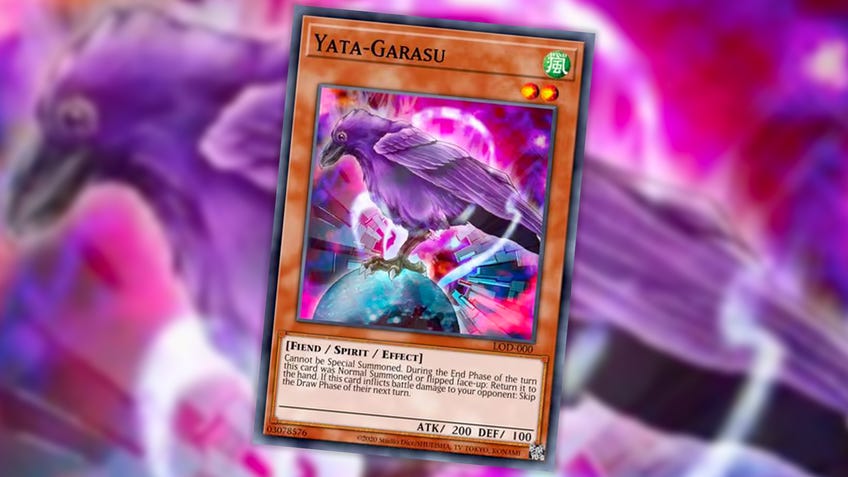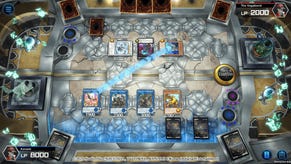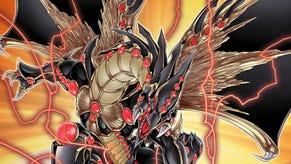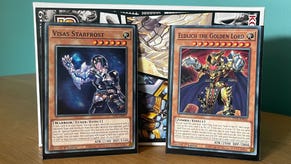6 best Yu-Gi-Oh! decks of all time from the card game’s 25-year history
From Yata Lock to Tearlaments.
As Yu-Gi-Oh! has evolved over the course of its 25-year history, the card game has evolved into something almost unrecognisable to where it once began. The summoning potential and speed of decks like Rescue-Ace, Rikka and the World Championship-winning Dragon Link strategy piloted by Paulie Aronson are far unlike the slower, less archetype-driven play of the early era of the game. These are just a few of the examples that would be cited by players as the best Yu-Gi-Oh! decks of the modern era.
Best Yu-Gi-Oh! decks
But what are the best Yu-Gi-Oh! decks of all time? Decks that, in their peak, were so dominant and overwhelming as to make them peerless. Decks that strike fear into those who lived through the peak of their control over the metagame. These are just a few of the Yu-Gi-Oh! decks which, in their prime, were almost unstoppable - and changed the TCG forever.
1. Yata Lock
Locking out the competition

It would be impossible to create a list of the best Yu-Gi-Oh! decks of all time and not mention Yata Lock. While not the first meta deck and strategy to be developed in the game’s history, it was certainly the most dominant and controlling in the early years of Yu-Gi-Oh!, a precursor of what was to come and the catalyst for the Forbidden and Limited List that keeps the game in check to this day.
What made Yata Lock so fearful was how controlling it could be in that far slower era. At the time, it was far less common for players to be able to concoct strategies from the Graveyard or retrieve cards from the deck outside of the Draw Phase. A card with the power to skip this was always going to be something to be feared, and a deck dedicated to bringing this card out onto the field and preventing the opponent from playing was a disruptive force. So powerful and overwhelming was this strategy that it left Konami with little choice but to ban the deck out of existence - a legacy where even the fear of history repeating itself kept the card banned long after the game sped past the monster’s viability as a meta-strategy.
Yata Lock’s legacy lives on as one of the first dominant decks in the history of the game and the best Yu-Gi-Oh! deck from the early era of the TCG, transforming a small purple bird into something feared and exiled for almost 20 years following its devastating burst to prominence.
2. Goat Control
Time for a bleat-down

Goat Control, during its prime, was the dominant deck in one of the final vestiges of competitive Yu-Gi-Oh! prior to the mainstreaming of archetype-driven and Special Summon-heavy decks spearheaded by the introduction of Cyber Dragon. This deck took advantage of the power cards of the era like Graceful Charity, Delinquent Duo and Pot of Greed, alongside the power of Scapegoat to facilitate the summon of power cards like Thousand-Eyes Restrict for ultimate control. It was dominant, developing into a deck so controlling that it would take 100% of top spots at major events like SJC New Jersey.
Unlike many of the other decks on this list, however, it’s one long-time fans who experienced this domination remember fondly. As a last vestige of slower play before Cyber Dragon began an intense Special Summon-fueled power creep, niche groups of players find joy in returning to this era as a way to experience an older, now-lost style of competitive Yu-Gi-Oh! The deck also isn’t entirely without competition; while certainly weaker, Chaos decks of the time were able to put up a fight.
That being said, the control this deck could exert understandably turned it into one of the most powerful Yu-Gi-Oh! decks in the history of the game, remembered as such even today. And, hey, it was certainly better than being pecked into submission by Yata-Garasu or dealing with a Magical Scientist FTK.
3. Dragon Rulers
One dragon (or four) to rule them all

Unless you were playing Yu-Gi-Oh! during the early 2010s at the time Dragon Rulers was first unleashed onto the competitive scene, it’s hard to fathom just how disruptive and all-consuming this deck was. Sure, it had at least some competition from Spellbooks during its era, but that’s another deck that only misses this list by virtue of being outshone by this one and the same format.
Dragon Rulers were terrifying not just for their power but for their consistency. The four elemental boss monsters were generic, spammable dragons that could fit into just about any elemental deck of the time, summoned from the deck by their smaller counterparts and able to bring themselves back into battle at a near-relentless pace. Played together with all dragons in a single deck, however, with the ability to return banished dragons with Return from the Different Dimension and draw near-endlessly with Super Rejuvenation, it soon became clear that even negating a summon or countering their play would not be enough to stop them.
It was no surprise that their unpopularity and dominance led to the cards being impacted almost immediately following their release. Konami tried banning the smaller dragons with the hope of hurting their consistency, eventually limiting the boss monsters to one copy per deck before banning all the Dragon Rulers outright. To this day, two of the monsters remain banned with the others limited to a single copy each - such is a testament to their unrivaled strength and speeds as one of the best and most powerful Yu-Gi-Oh! decks ever made.
4. PePe
No clowning around

Performapal and Performage brought the often-overlooked Pendulum mechanic to its most potent state. Perhaps too potent, many would argue - including Konami, for whom the strength of the deck was so overwhelming that it took an unplanned adjusted Forbidden and Limited list to bring balance to a game that many decried as being in disrepute by the nature of the strength of the deck.
The strategy of the PePe deck was simple: Pendulum Summon as many Level 4 monsters as possible and use that to unleash powerful Xyz monsters that can overwhelm an opponent. It sounds simple enough in concept, but when this is coupled with the versatility and ease to set up Pendulum Zones and summon monsters like that offered by Monkeyboard, Skullcrobat Joker and Plushfire, the results are truly frightening. Many of these cards could set up the Pendulum Scales singlehandedly through combos fueled by their effects, circumventing the checks and balances inherent to the mechanic.
The results spoke for themselves. At YCS Atlanta in 2016, 29 of the decks in the top 32 were PePe, and it was only with the emergency banlist that made forbidden the use of Plushfire and Tellarknight Ptolemaeus, alongside the limiting of Monkeyboard, that the deck was pulled back down to Earth.
While we’ve had decks earn dominant performances at major events such as YCS tournaments in the past, showcasing their strength in the meta, few have been so dominant as PePe, and few require Konami to so forcefully step in to adjust the Forbidden and Limited List in response.
5. Zoodiac
As easy as Xyz

If PePe transformed the Pendulum mechanic by circumventing the limitations required to perform a Pendulum Summon, the same could be argued for Zoodiac’s impact on Xyz summons. What made this deck so dominant during its peak was the fact that just a single Zoodiac monster was all that was needed in order to summon one of the archetype’s many Xyz monsters, rather than the typical requirements for two or more monsters of the same level needed for other Xyz monsters.
No other deck could compete in terms of consistency when you have free access to your Extra Deck for Zoodiac Xyz monsters at any time. Not only is this a mechanic ripe for abuse of the numerous Xyz monsters that themselves can be summoned by overlaying themselves on top of other Xyz monsters, the effects of these Zoodiac Xyz monsters were often overwhelming with enough counters to overcome just about any hurdle. Zoodiac Barrage could Special Summon any Zoodiac monster from the deck. Zoodiac Broadbull could search out any Beast-Warrior in the game, while Zoodiac Drident can destroy any card on the field during either player's turn. And that’s just the start.
Only the Yu-Gi-Oh! banlist could pull the deck down. Yet, even then, the ability of the deck to adapt itself to any limits placed upon it by Konami allowed it to persevere far beyond its initial peak at the top of the meta. Only the fact that all three of the above-mentioned Xyz monsters remain banned keeps the deck from maintaining a stranglehold on the game, a testament to their continued power over the current metagame.
6. Ishizu Tearlaments
Shed a tear for Tearlaments

The most recent deck on the list yet undoubtedly one of the best ever to grace the game of Yu-Gi-Oh!, this variant of the Tearlaments deck earns its place in history for how the four upgraded versions of Ishizu’s Fairy monsters from the original anime - hence the name - enhance the deck to play past the weaknesses in consistency that once held them back.
Tearlaments is an archetype whose gimmick comes from effects that require players to send cards from the deck to the Graveyard in order to activate their effects. While the effects of these monsters to Special summon themselves and other cards as well as removing problematic cards through milling the deck helped them to compete against the likes of Runick and Spright, their weaknesses in terms of consistency held them back. The Ishizu monsters countered these weaknesses, helping to shuffle monsters back into the deck and extend combos through their own Graveyard effects, stepping in to negate counters from opponents to keep combos going for longer. They even allowed the deck to begin combos during the opponent’s turn.
The result? An unbroken three-month streak of YCS victories before hits on the Forbidden and Limited List brought them back down to Earth and elevated Kashtira, the last gasp of dominance on the game’s transition into the balanced metagame we enjoy today.









